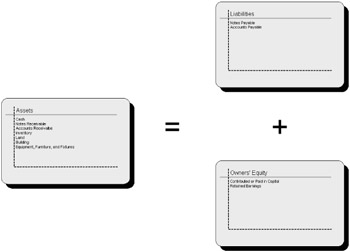Appendix E: Accounting Reference
|
This appendix contains basic accounting principles discussed in most first- and second-semester accounting classes. These concepts are aimed at report developers whose primary disciplines are not accounting.
Basic Accounting Principles
The following are general accounting principles utilized by most companies:
-
The accounting period is usually defined as one year, ending on December 31. The fiscal year may end on any date of the year.
-
Revenue is earned when the business has completed rendering services to the customer. The amount to record is equal to the cash value of the services or goods.
-
Expenses are matched against the revenues in the same accounting period.
-
Financial information is reported at regular intervals.
-
Most accounts list information as debits or credits. A debit is an item of debt as recorded in an account. A credit is the deduction of a payment made by a debtor from an amount due.
-
Debits are entered on the left side of an account. Credits are entered on the right side of an account (see the section titled "Recording Transactions" later in this appendix for more information).
-
The basic accounting equation is: assets = liabilities + owners' equity. Figure E-1 summarizes this equation in a graphical representation:

Figure E-1: The accounting equation
The accounts of the accounting equation are defined in the following sections.
Asset Accounts
Assets are the economic resources expected to benefit a company in the future. Assets are usually divided into the following seven accounts:
-
Cash: Money, certificates of deposit, and checks
-
Notes Receivable: Promissory notes
-
Accounts Receivable: A promise (either oral or implied). These usually come from sales made to customers where no promissory note exists.
-
Inventory: Merchandise that a company holds or manufactures to sell.
-
Land: The property the company owns and uses to operate.
-
Building: The cost of offices, warehouses, garages, etc.
-
Equipment, furniture, and fixtures: The cost of all office equipment of a company.
Liabilities
Liabilities are the economic obligations, or debts, of a company. Liabilities are usually divided into the following two accounts:
-
Notes Payable: The amounts a company must pay as a result of signing a promissory note for goods or services.
-
Accounts Payable: The promise (either oral or implied) to pay debts from credit purchases.
Owners' Equity
Owners' Equity includes all claims held by the company's owners. Owners' equity is usually divided into the following two accounts:
-
Contributed or Paid in Capital: The amounts invested in the company by the owners.
-
Retained Earnings: The incomes earned from the company operations. Often, you'll find this area divided into three subareas.
-
Expenses: The decreases in retained earnings resulting from company operations.
-
Revenues: The increases in retained earnings resulting from company operations.
-
Dividends: The distributions of assets to shareholders (which result in a decrease in retained earnings).
-
|
EAN: 2147483647
Pages: 177